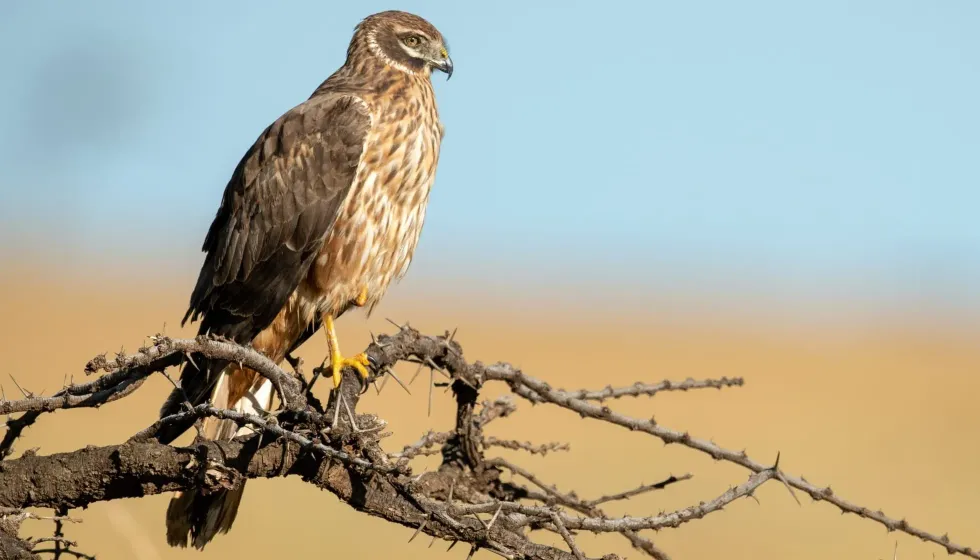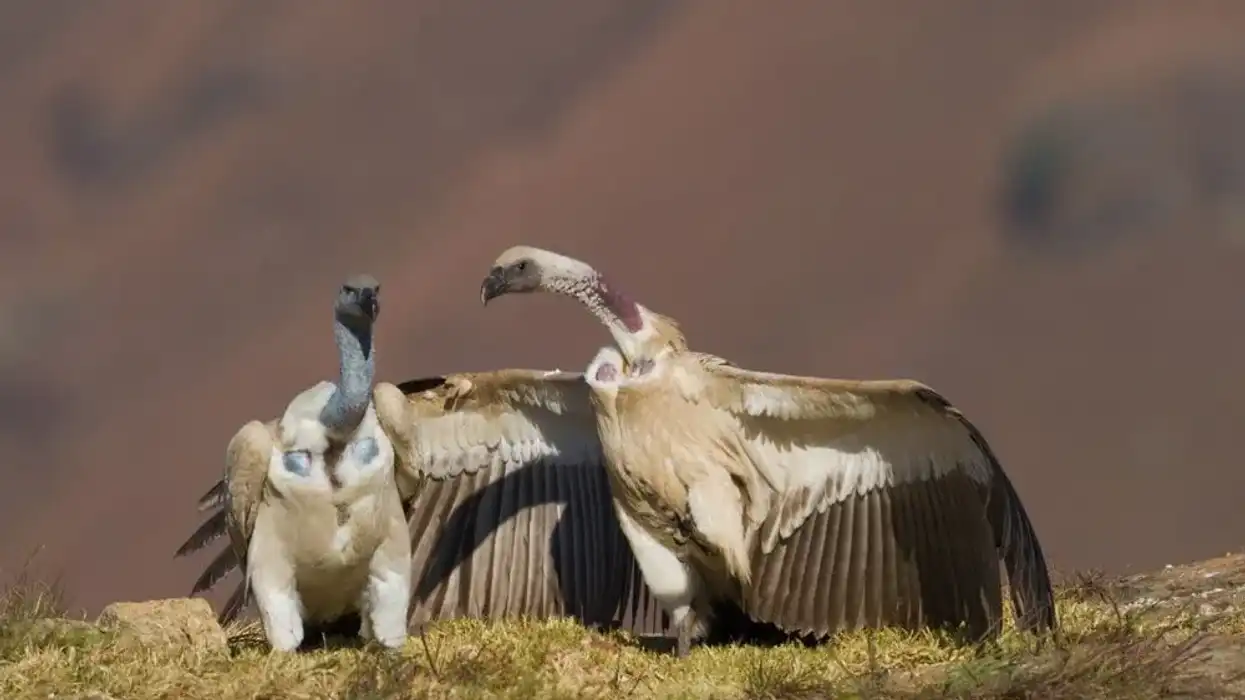The African marsh harrier is a very large bird of prey with deadly looks. This bird belongs to phylum Chordata, order Accipitriformes, and genus Circus. They are also called wetland harriers.
Their long slender wings and tail make them magnificent. Adults of this harrier species have dark brown and gray plumage, their flight feathers are streaked rufous, and the wing-coverts are white.
These birds have one distinguishing feature from other harriers because they have a rump of darker brown and not white. However, only the the female African marsh harrier has the feature. Their major distribution is in wetlands habitats.
They inhabit areas around swamps, moist lands, and can be seen mainly in eastern, central, and South Africa. They have a two-note display call.
They feed on small vertebrates and insects that they mostly catch in flight. These harriers are not migratory birds and they don’t leave their territory. The increasing destruction of wetlands is now creating problems for them, but they can adapt quickly to a new habitat.
Have an interest in birds and want to know about more of them? Here you can know some amazing facts about the red-necked phalarope and golden pheasant!
African Marsh Harrier Interesting Facts
What type of animal is an African marsh harrier?
The African marsh harrier is a type of bird of heavy build and dark brown color. The females are 30% heavier than the males. Adult African marsh harriers possess yellow eyes.
What class of animal does an African marsh harrier belong to?
This species belongs to the Aves class, family Accipitridae, and genus Circus. Their scientific name is Circus ranivorus.
How many African marsh harriers are there in the world?
These birds are in abundance in Africa and some other parts of the world. Their estimated population range is between 10,000-100,000 individuals.
Where does an African marsh harrier live?
This species prefers regions of wetlands and their distribution can be seen in the countries of southern Africa mainly Zambia, Uganda, south Tanzania, Botswana, southern Mozambique, the Democratic Republic of Congo, Swaziland, south Malawi, South Africa, Rwanda, South Sudan, and Kenya.
What is an African marsh harrier habitat?
The marsh harrier distribution is mainly in the marshes of Africa, and they hunt in open grasslands and wetland cultivation. Moist areas like reedbeds, swamps, grasslands, inland, and coastal wetlands are other habitats where you can find these birds.
You can find them above a sea level range of 9842.5 ft (3000 m). They can be seen in eastern Africa and above 13,123 ft (4000 m) in Ethiopia.
Who does African marsh harrier live with?
They are solitary birds and are rarely seen in groups or colonies. They prefer to solitary roost. Also, their nests are placed 0.6-1.9 mi (1-3 km) apart from each other.
How long does an African marsh harrier live?
The average lifespan of African marsh harrier birds is six years which is a very good amount of time for a harrier species. Adults have a survival rate of 74% year on year.
These birds have a good chance of reaching their third year which is when they begin breeding. The longest lifespan recorded for the Busard grenouillard is around six and a half years.
How do they reproduce?
Being monogamous in nature, they have long-term pair bonds. During their breeding season, they become highly territorial. The egg-laying time happens throughout the year, but most birds lay eggs between June and November because they prefer the dry season.
Males and females build the nest with dry sticks, leaves, and twigs. Their nests are placed near the water in a large wetland. Bushy areas around trees above water are also preferred for nesting too.
They build one nest and use it for many breeding seasons. A female lays a clutch of two to five light blue and white eggs and serves the incubation period alone for 30 days.
The male brings food for both the baby and the mother. The juvenile is dark at the start. The chicks become fully independent after 29-40 days after hatching and then leave the nest to hunt for themselves.
What is their conservation status?
According to the International Union for Conservation of Nature (IUCN), this Circus ranivorus bird of genus Circus is under the category of Least Concern species. Their population trend is continuously decreasing and in some countries, they are even regarded as regionally endangered.
They are now losing their habitats to overgrazing, pesticide poisoning, and damming of wetlands. However, the population is still thriving in South Africa.
African Marsh Harrier Fun Facts
What does the African marsh harrier look like?
These birds of Africa are large, heavy birds. Their neck, head, and upper parts are edged and streaked with white color.
The lower breasts and thighs are rufous and the underwings are streaked with dark brown. The flight feathers and the tails have dark barring at every stage of their life. They are gray-brown from below and sooty brown from above.
They have a very colorful bill of black and yellow colors and the eyes are also yellow. Both sexes are similar-looking except for the distinguishing feature of a darker shade of brown and large size of the females, as the males have gray flight feathers. Their juveniles are dark gray and have buff tips to upper wing coverts.
On the breast area, a broad white and creamy breast band with black streaks can be seen. Their crown and ear coverts are streaked with buff.
How cute are they?
They are not cute birds and they look very aggressive.
How do they communicate?
They are not sound birds and they prefer to stay silent. The African harrier hawk call can only be heard during the breeding season and courtship displays. It is a two-note display call.
When the male feeds the female and the babies, a soft call of 'pew' can be heard around the nest to which the female responds with 'jeeeek' call. When they are in the air, they produce a high-pitched 'feeooo' sound. When they are in a situation of alarm or threat, they produce many soft notes.
How big is an African marsh harrier?
The harrier African marsh (Circus ranivorus) is 17.3-18.5 in (44-47 cm ) long. They are five times longer than the small nuthatch bird of the same class Aves.
How fast can an African marsh harrier fly?
The African marsh harrier hawk has a large wingspan which helps it to fly high in the sky. They are good fliers, but the African marsh harrier in flight speed is not known yet. The fastest flying hawk of the same class Aves is the peregrine falcon.
How much does an African marsh harrier weigh?
This flight bird of this southern African bird with streaked rufous is 14.1-22.9 oz (400-650 g) in weight. A similar hawk bird is the chicken hawk is twice the weight of this bird.
What are the male and female names of the species?
There are no specific names for the male and the female of this species. The male of this species is called a male African marsh and the female is called a female African marsh. This species has its population range in abundance in southern Africa.
What would you call a baby African marsh harrier?
The cute little babies of this bird are called chicks. The juvenile bird has dark feathers.
What do they eat?
They are carnivores and the diet consists of small vertebrates and rodents. The Busard grenouillard eats, frogs, lizards, reptiles, worms, caterpillars, fish, and carrions.
Are they dangerous?
These large flight birds are bold and can show aggressive nature. Their claws and beak are very sharp which make them dangerous.
Would they make a good pet?
Harriers will not make good pets at all. They are wild creatures and birds of prey. They have many methods of defense they can use if they feel threatened, either by you or an external predator. You should avoid getting too close to them.
Did you know...
This species of South Africa with rufous underparts are very similar to an owl in looks. They both have a round face and almost the same hunting skills.
Harriers use their acute hearing ability to detect the location of their prey to catch them. The head of harriers is streaked with white color and they have a gray tail. Even though they look similar to owls, the population range of marsh harrier birds is greater as they have a status of Least Concern.
What's the wingspan of an African marsh harrier?
These birds have slender wings with a wingspan of about 41.3-49.2 in (105-125 cm).
How do you identify an African marsh harrier?
It can be a little difficult to identify the African harrier as many hawks and hobbies look similar to them. They spend most of their time flying low over marshes with wings raised in shallow 'V'.
The dark brown plumage is a very common attribute but their creamy cap and throat can help to identify them. Due to their Least Concern status, they are easy to find. Males are brighter have colorful upper wings, pale markings on breast and head, rusty abdomen, and gray tail with dark barring.
Here at Kidadl, we have carefully created lots of interesting family-friendly animal facts for everyone to discover! For more relatable content, check out these hornbill facts and hermit thrush facts for kids.
You can even occupy yourself at home by coloring in one of our free printable African harrier hawk coloring pages.









